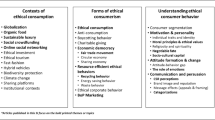Abstract
Marketing researchers have long used brand switching analyses and Markov transition matrices to gain insights into managerial problems. Almost without exception, this work makes (inappropriate) inferences about individual consumers by analyzing household-level data. This paper presents a procedure based on the distribution of run lengths in household level panel data that allows more insights into the choice behavior of the individuals in the household. We test these procedures in a large simulation study by attempting to recover the underlying (known) structure of the process generating a string of panel data. Finally, we use the procedure to classify the purchase behavior, with respect to powdered soft drinks, of a set of households in a panel. Our results show that marketing scientists have the potential to learn and test more hypotheses about the individuals in a household by examining the distribution of run lengths.
Similar content being viewed by others
References
Bass, Frank M., Moshe M. Givon, Manohar U. Kalwani, David Reibstein, and Gordon P. Wright. (1984). “An Investigation into the Order of the Brand Choice Process,”Marketing Science 3 (Fall), 267–287.
Bawa, Kapil. (1990). “Modeling Inertia and Variety Seeking Tendencies in Brand Choice Behavior,”Marketing Science 9 (Summer), 263–278.
Corfman, Kim P., and Sunil Gupta. (1993). “Mathematical Models of Group Choice and Negotiations,” In Jehoshua Eliashberg and Gary L. Lillien (eds.),Handbook in ORGMS: Marketing. Boston: Kluwer, 81–140.
Corfman, Kim P., and Donald R. Lehmann. (1987). “Models of Cooperative Group Decision-Making: An Experimental Investigation of Family Purchase Decisions,”Journal of Consumer Research 14 (June), 1–13.
Corfman, Kim P., and Donald R. Lehmann, and Joel H. Steckel. (1990). “Longitudinal Patterns of Group Decisions: An Exploratory Analysis,”Multivariate Behavioral Research 25 (July), 249–273.
Frank, Ronald E. (1962). “Brand Choice as a Probability Process,”Journal of Business 35 (January), 43–56.
Givon, Moshe M. (1984). “Variety Seeking through Brand Switching.”Marketing Science 3 (Winter), 1–22.
Jeuland, Abel P., Frank M. Bass, and Gordon P. Wright. (1980). “A Multibrand Stochastic Model Compounding Heterogenous Erlang Timing and Multinomial Choice Process,”Operations Research 28 (March–April), 255–277.
Kahn, Barbara E., Manohar U. Kalwani, and Donald G. Morrison. (1986). “Measuring Variety Seeking and Reinforcement Behaviors using Panel Data,”Journal of Marketing Research 23 (May), 89–100.
Kahn, Barbara E., Donald G. Morrison, and Gordon P. Wright. (1986). “Aggregating Individual Purchases to the Household Level,”Marketing Science 5 (Summer), 260–268.
Kalwani, Manohar U., and Donald G. Morrison. (1977). “A Parsimonious Description of the Hendry System,”Management Science 23 (January), 467–477.
Kerr, Norman L., Garold Stasser, and James H. Davis. (1979). “Model Testing, Model Fitting, and Social Decision Schemes,”Organizational Behavior and Human Performance 23, 399–410.
Lehmann, Donald R. (1972). “Judged Similarity and Brand-Switching Data as Similarity Measures,”Journal of Marketing Research 9 (August), 331–334.
Massy, William F., David B. Montgomery, and Donald G. Morrison. (1970).Stochastic Models of Buying Behavior. Cambridge, MA: MIT Press.
Steckel, Joel H., Kim P. Corfman, David J. Curry, Sunil Gupta, and James Shanteau. (1991). “Prospects and Problems in Group Decisions,”Marketing Letters 2 (August), 231–240.
Steckel, Joel H., Donald R. Lehmann, and Kim P. Corfman. (1988). “Estimating Probabilistic Choice Models from Sparse Data: A Method and an Application to Groups,”Psychological Bulletin 103 (January), 131–139.
Author information
Authors and Affiliations
Additional information
We gratefully acknowledge Professor Bari Harlam of the University of Rhode Island for providing the panel data.
Rights and permissions
About this article
Cite this article
Gupta, S., Steckel, J.H. Preference aggregation and repeat buying in households. Marketing Letters 4, 321–336 (1993). https://doi.org/10.1007/BF00994351
Issue Date:
DOI: https://doi.org/10.1007/BF00994351




